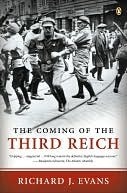What one historian has called a ‘quasi-guerrilla warfare’ was being conducted in the poorer quarters of Germany’s big cities, and the Communists were slowly being beaten back into their heartlands in the slums and tenement districts by the continual brutal pressure of brownshirt violence. In this conflict, bourgeois sympathies were generally on the side of the Nazis, who, after all, were not threatening to destroy capitalism or create a ‘Soviet Germany’ if they came to power.
Welcome back. Just a moment while we sign you in to your Goodreads account.


